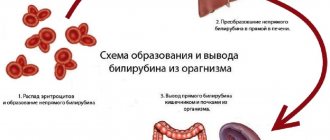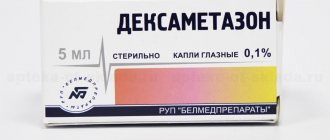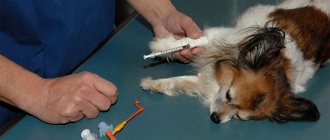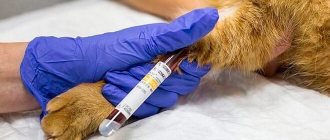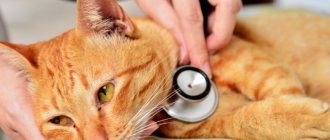Possible reasons for deviations
The Ritis coefficient is the ratio of the enzymes, aspartate aminotransferase (AST) and alanine aminotransferase (ALT). In a healthy dog it is from 1.33 to 1.75 units/l. Its upward deviation is provoked by an AST indicator increased by 8-10 times, which indicates:
- Viral infection;
- Heart diseases that accompany necrosis;
- Poisoning of an animal with toxic substances.
A reduced Ritis coefficient is observed when alanine aminotransferase is increased by 8-10 times. Its presence in the range from 1 to 1.3 units/l indicates the presence of damage to the liver tissue. When the level does not reach 1 unit/l, veterinarians diagnose acute liver disease. A deviation from the norm to a lesser extent is evidence of viral hepatitis, piroplasmosis, babesiosis and other liver diseases.
Diagnostic value
In clinical practice, determination of AST and ALT activity in blood serum is widely used to diagnose certain diseases. Determining the activity of these enzymes in the blood has diagnostic value because these enzymes have organ specificity, namely: ALT predominates in the liver, and AST predominates in the myocardium, therefore, with myocardial infarction or hepatitis, increased activity in the blood of any given enzyme will be detected . Thus, during myocardial infarction, AST activity in the blood increases by ~8-10 times [1], while ALT only increases by 1.5-2 times [1].
In hepatitis, the activity of ALT in the blood serum increases by ~8-10 times[1], and AST - by 2-4 times[1] compared to normal. The Ritis coefficient decreases to 0.6[1]. However, with liver cirrhosis, this coefficient increases, which indicates cell necrosis, in which both forms of AST are released into the blood.
The norm for AST is up to 40 IU or up to 666 nmol/s*l, for ALT up to 30 IU or up to 666 nmol/s*l [source not specified 3282 days].
The de Ritis coefficient within normal values (0.91-1.75) [1] is usually characteristic of healthy people. However, an increase in AST with a simultaneous increase in the AST/ALT ratio (de Ritis coefficient greater than 2) indicates cardiac damage, and we can confidently speak about myocardial infarction or another process associated with the destruction of cardiomyocytes [3] [4].
In clinical practice, determination of AST and ALT activity in blood serum is widely used to diagnose certain diseases. Determining the activity of these enzymes in the blood has diagnostic value because these enzymes have organ specificity, namely: ALT predominates in the liver, and AST predominates in the myocardium, therefore, with myocardial infarction or hepatitis, increased activity in the blood of any given enzyme will be detected . Thus, during myocardial infarction, the activity of AST in the blood increases 8-10 times[1], while ALT only increases by 1.5-2 times[1].
With hepatitis, the activity of ALT in the blood serum increases by 8-10 times[1], and AST - by 2-4 times[1]. The norm for AST is up to 40 IU or up to 666 nmol/s*l, for ALT up to 30 IU or up to 666 nmol/s*l [source not specified 890 days].
The de Ritis coefficient within normal values (0.91-1.75) [1] is usually characteristic of healthy people. However, an increase in AST with a simultaneous increase in the AST/ALT ratio (de Ritis coefficient greater than 2) indicates cardiac damage, and we can confidently speak about myocardial infarction or another process associated with the destruction of cardiomyocytes [3] [4].
Signs of Imbalance
Symptoms of enzyme imbalance include:
Take the Attention Test! Find 10 differences! (click right here!)
Find the answer Are you bothered by some problem or question? Enter “Breed” or “Name of the problem” into the form, press Enter and you will find out everything about the issue that interests you.
- Chronic weakness;
- Loss of interest in food;
- Vomiting;
- Pain in the epigastric region;
- Bloating;
- Itching of the epidermis;
- Bleeding from the nose;
- Darkening of urine, light-colored stool.
Blood test in dogs: norm, interpretation, reasons for increase and decrease in indicators
A blood test to determine the ratio of AST and ALT is used to diagnose heart muscle or liver pathology in a dog.
ALT is synthesized by the liver and takes part in the process of amino acid metabolism. In a healthy dog, its value ranges from 1.6 to 7.6 IU.
Excess ALT is a sign of:
- Damage to the hematopoietic organ by toxins;
- Cirrhosis;
- Tumors in the liver;
- Heart failure;
- Pancreatitis;
- Burns;
- Injury;
- Muscle necrosis.
A decrease in ALT is caused by:
- Lack of adermin;
- Necrosis of liver tissue, cirrhosis.
AST takes part in amino acid metabolism. It is contained in cardiac, liver, kidney, nervous tissue, and skeletal muscles. In a healthy animal, AST ranges from 1.6 to 6.7 IU.
The level of AST in the blood can increase:
- Incidence of viral or toxic hepatitis, acute pancreatitis;
- The presence of a tumor in the hematopoietic organ;
- Excessive physical activity;
- This problem is heart failure;
- Trauma, burn, heatstroke.
AST leads to a low level of AST in a dog’s blood:
- Liver rupture;
- Lack of adermin;
- Serious illnesses.
The appearance of a sign of ALT and AST imbalance in an animal is a serious reason for sending it for testing. The results will be assessed by a veterinarian.
Passing a biochemical blood test requires compliance with the conditions that ensure the accuracy of the results:
- Refusal to use medications 10 days before the test;
- Elimination of fatty foods from the menu for 2 days;
- Taking the test in the morning on an empty stomach.
general information
Everyone knows that treating a disease at the very beginning gives a more effective result and a more favorable prognosis for recovery. But to prescribe the necessary treatment, timely detection of the disease is important.
Today, in medicine and veterinary medicine, various modern means are used to diagnose various diseases in the early stages. One of them is taking blood for various tests, including blood for biochemistry. It is in this analysis that the indicators of the enzymes aspartate aminotransferase and alanine aminotransferase are determined.
The coefficient owes its name to the Italian scientist de Ritis. It was he who determined the significance of enzyme levels in blood tests and, having calculated their ratio, introduced the coefficient itself into practice.
Clinical blood test in dogs
A clinical examination of the animal’s blood determines the stage of the inflammatory process, anemia, dehydration, the presence of tumors, hidden chronic, infectious, invasive and other non-infectious pathologies. To do this, analyze:
- Hematocrit, which shows the volume of red blood cells.
- Hemoglobin is a protein that ensures the intercellular transport of oxygen and carbon dioxide molecules.
- Hemoglobin-containing cells known as erythrocytes.
- An indicator called color and determining the degree of intensity of erythrocyte color.
- An average value indicating the concentration of hemoglobin in red blood cells.
- The sedimentation rate of blood cells containing hemoglobin.
- White cells, known leukocytes. The body's immune response depends on them.
- Individual white blood cells called myelocytes. A healthy individual has none.
- Reticulocytes - immature red blood cells;
- Plasmocytes that form lymphoid tissue. A healthy individual has none.
- Platelets responsible for hemostasis.
Dangerous deviations in indicators in a cat
Deviations from the norm (increased or decreased) indicate that a malfunction has occurred in the body. Monitoring allows you to timely identify the development of the disease and begin treatment.
Bilirubin
Bilirubin is part of bile.
An overestimated value indicates the development of liver diseases (hepatosis, hepatitis), as well as blockage of the bile ducts.
Scheme of bilirubin formation in the blood
A decrease in bilirubin levels is observed with anemia and bone marrow lesions.
Total protein
An increase is observed with dehydration due to vomiting and diarrhea. A decrease in protein levels is typical for intestinal diseases, chronic liver diseases (cirrhosis or hepatitis), renal failure, and fasting.
Similar article - Why do you want sweets before your period?
Creatinine
An increase in blood creatinine levels may indicate the development of hyperthyroidism or kidney failure. A decrease in this value is observed during protein starvation.
Urea
An increase in urea indicates impaired kidney function and blockage of the urinary tract. Also, an excess of this value is observed when feeding your pet food rich in animal protein.
Uric acid crystals under a microscope
A decrease in urea indicates intestinal dysfunction, liver pathologies or protein deficiency in the diet.
Glucose
The reasons for increased blood glucose are as follows:
- Cushing's syndrome;
- diabetes;
- release of adrenaline into the blood due to increased physical activity or severe stress;
- chronic kidney or liver diseases;
- pancreatitis;
- pancreatic tumors.
A decrease in value is observed with an overdose of insulin, prolonged fasting, poisoning with poisons or alcohol.
Blood glucose
Low glucose levels are also characteristic of pancreatic diseases.
Amylase
An increase in the rate is observed in the following diseases: pancreatitis, diabetes mellitus, peritonitis, volvulus, renal failure.
A decrease in the indicator may be the result of taking anticoagulants, poisoning, or necrosis of pancreatic tissue. The analysis determines total amylase and pancreatic amylase. The norm is 500-1200 units/l.
Cholesterol
An increase in cholesterol levels is typical for pancreatitis, diabetes mellitus, hypothyroidism and kidney disease.
AST and ALT
An increase in these indicators indicates the destruction of liver cells, which was caused by cirrhosis, hepatitis or other diseases. Also, an increase in AST and ALT can be a consequence of injury or heart failure.
Alkaline phosphatase
Increased alkaline phosphatase can occur in pregnant animals and in pets that eat fatty foods.
A decrease in the level of alkaline phosphatase is observed with anemia, vitamin C deficiency, and long-term use of corticosteroids.
Alkaline phosphatase is a whole complex of enzymes that is found almost throughout the body in small quantities.
Phosphorus
An increase in phosphorus is characteristic of leukemia and bone tumors. Also, a high value is observed in renal failure, hypervitaminosis of vitamin D, and disorders of the endocrine system.
Long-term diarrhea also leads to a decrease in the indicator.
Calcium
An increase in calcium is typical for:
- dehydration;
- destruction of bone tissue due to cancer;
- excess vitamin D.
Calcium deficiency is observed with pancreatitis, lack of vitamin D, taking anticonvulsants, and chronic renal failure.
Biochemistry of dog blood
Among the studied indicators you can see:
- ALT and AST. Based on their deviation from the norm, cardiac or hepatic pathology is diagnosed.
- Glucose. The condition of the pancreas is determined by its level.
- Urea. Allows you to evaluate how the hepatobiliary and excretory systems function.
- Creatinine. The indicator is necessary to assess renal function.
- GGT. It is used to determine liver diseases.
- Alpha amylase. May indicate a problem in the functioning of the pancreas and salivary glands.
- Phosphatase. Exceeding the norm indicates diseases of the skeletal system, liver, and tumors in the prostate gland.
- Bilirubin. Speaks of diseases characterized by intense breakdown of red blood cells.
- Contents of Ca, P, K, Na, Mg. Their balance is necessary for nerve impulses to reach the brain.
- Lipase. Deviations from the norm are evidence of pulmonary, gastric, intestinal, and liver pathology.
The need for a blood test
There are symptoms that indicate the need to take the animal to the veterinarian and donate blood for a biochemical analysis to check enzyme activity. This symptomatology coincides with the symptoms that appear in liver diseases. They are also characteristic of humans. This:
- Pigmentation of the skin, mucous membranes and sclera (a yellow tint appears).
- Vomit.
- Fatigue, tiredness (the animal lies down more and more).
- The color of urine (darkened) and stool (discolored) changed.
After passing the tests, the veterinarian will determine the activity of AST and ALT, deviations from the norm, and calculate the de Ritis coefficient - whether it is low or high.
It should be noted that the coefficient itself is meaningless if the enzymes are at normal levels. And it is calculated only when the analysis shows an increase or decrease in the level of any enzyme, to determine where exactly the problems arose - in the liver or in the heart.
Prepare before going to the vet
In the office, you may have to provide the veterinarian with all possible assistance (hold the animal while they take blood for analysis, give an injection, extinguish aggression, calm your voice, scratch its ears, stroke it). If you know that you are terrified of blood, IVs, or definitely cannot withstand the type of medical interventions, then perhaps you should ask a friend or relative for help.
Find a veterinary certificate, veterinary passport.
Take:
- Leash;
- Collar;
- Muzzle;
- Carrying;
- A pack of napkins;
- litter;
- Bowl, water (at the veterinarian's discretion)
Prepare answers to possible questions from the veterinarian:
- Are all vaccinations up to date on the animal?
- Pet’s behavior in recent days, appetite;
- His diet;
- What drugs and medicines did you give to the animal;
- Latest test data (if available).
It’s better to make an appointment in advance - you’ll save time and be able to calculate when you’ll have to take time off. This does not apply to life-threatening situations where you will have to take an animal to a veterinary clinic without an appointment.
Be affectionate with your pet, play, talk to him. You can take his favorite toy with you so that while you wait for your turn at the reception, you can distract your friend from the new environment.
Furry, feathered or scaly ones also need to be prepared. No matter how much you want to treat your little one with something tasty, remember: you need an empty stomach. Feeding is prohibited!
You can wash your animal without using detergents. But it is important not to touch your pet if there is nasal discharge, watery eyes, salivation (salivation), dandruff, scratching, rashes, skin scabs, loss of hair/feathers/scales, wounds and other external manifestations of a potential disease.
If the veterinarian has instructed, collect the animal’s urine in a sterile container, and pick up the feces with a stick (no blades of grass, specks, or debris). Transfer the feces into a sterile container. Send to the biochemical laboratory within 6 hours. The feces are examined for eggs of roundworms, pinworms, tapeworms, liver flukes, echinoccus, alvecoccus, pork tapeworm, bovine tapeworm, and gastrointestinal bleeding is detected.
At the veterinary hospital, the animal’s blood will be analyzed for antibodies to allergens, viruses, bacteria, and parasites.
Choosing a veterinary clinic
We determine the veterinary clinic where you plan to go. A big PR company doesn't promise quality. The price is explained by the huge amount of money invested in advertising and “signboarding” of the establishment.
It’s great if you can ask your friends about clinics where their pets were treated “humanely.” If you travel far from them, it may be worth sacrificing time for the health of your pet.
A few more tips on how to spot an unverified veterinary clinic:
- Refusal to provide certificates and licenses for veterinary activities.
- Strange and suspicious behavior of the veterinarian (inconsistency, flattery, attempts to intimidate, shouting).
- Prices are too low (compared to other organizations).
- Refusal to freely visit the veterinary clinic.
“We have a sanitary day”
Beware of scammers!
When you contact the veterinary clinic, you are informed: “we cannot accept you at this address, sanitary day/repair/inspection.” How much intelligence does a dispatcher have? The client is persuaded to have a veterinarian come to his home. The price does not change.
A veterinary clinic can exist purely nominally. And the invited “Aibolit” will not bear responsibility. There is a high probability of running into a person without a veterinary diploma or simply an unprofessional.
It is better to find time to visit the veterinary clinic on your own. This is safer for the animal.
Significance of changes in the de Ritis coefficient
The de Ritis ratio is the ratio of AST and ALT. For a cat, the norm is 1.3 (error in both directions is 0.4). For chronic liver diseases, the coefficient varies from 1 to 1.3. If it falls below one, it means that the disease is acute. At the same time, the level of ALT increases.
The de Ritis coefficient in cats is an indicator indicating cardiac or liver pathologies
An increase in the coefficient above 1.3 indicates diseases of the heart muscle, incl. myocardial infarction. This indicator is also characteristic of liver damage from toxins.
Also, with the help of such a study, it is possible to evaluate the functioning of the animal’s internal organs, reaction to a new diet, etc. During treatment, biochemistry is performed several times to see how effective the prescribed therapy is.
Owners, when bringing a sick cat to a veterinary clinic, are almost constantly faced with the fact that veterinary specialists, in addition to a clinical examination of the sick cat, conduct a blood sample test from the sick animal in order to make an accurate diagnosis of the disease. Modern effective treatment of a sick animal cannot be based only on examining the sick animal.
If not so long ago no one seriously took the possibility of conducting a study to assess the condition of an animal using a clinical and biochemical blood test in the laboratory, today every self-respecting veterinary specialist, and even more so a modern veterinary clinic, considers it the norm to do a blood test on their patients.
A blood test is one of the most informative ways to examine pets. By conducting a blood test, a veterinarian has the opportunity not only to confirm or refute the clinical diagnosis, but also to identify hidden pathological processes in the animal’s body (subclinical pathology) that have not yet produced characteristic symptoms.
The main types of research are general clinical and biochemical blood tests. Using the CBC, you can establish the basic composition of the blood. Biochemical research allows a veterinary specialist to more accurately judge the functional state of the animal. Before performing an operation or other intervention, a blood test is a mandatory norm.
Games on feelings
In real veterinary clinics there will be elements of “divorce”.
Veterinarians say that this is often determined by the client’s wallet. The greater the opportunity to pay for services and the more the owner worries about his pet, the more likely the animal will be prescribed additional immunostimulants, dietary supplements, water-soluble and fat-soluble vitamins, and special food. There are cases when this is really necessary (pedigreed, show animals, weakened after a serious illness). But it will be good if you ask your veterinarian in detail about the need for each appointment. Find out in detail about the results of the examination and analysis of your pet’s condition. Be persistent. Do not give in to attempts to intimidate you, be consistent in your questions. Consult a specialist who does not work at this veterinary clinic. If it turns out that half of the prescriptions are prescribed to enrich the veterinarian’s pocket, and not for the health of the animal, feel free to leave. And do not forget to leave a negative review about the organization - other owners may also suffer.
How to find out the truth
Another possible way for veterinarians to make dishonest money is to conceal the diagnosis. Let's say a veterinarian discovers a malignant tumor in a cat. But if he says that the tumor is benign and treatable. A housewife who dotes on her pet will give money for already useless procedures, medications and surgical interventions.
The veterinarian may deliberately “downplay” the diagnosis in order to earn more money. If something doesn't add up, insist on clarification. There is no need to be intimidated by unfamiliar terms - take a short break and try to find information on the Internet.
You are free to leave (or threaten to do so) to another clinic at any time.
Make sure that the veterinary clinic is honest - get tested in an independent laboratory.
Justice
What to do if an animal was injured as a result of unprofessional actions of a veterinarian:
- Write an official complaint addressed to the head of the clinic.
- File a complaint with the city veterinary department.
- You can contact Rospotrebnadzor.
- Contact a lawyer for help
The Law “On the Protection of Consumer Rights” and Article 245 of the Criminal Code “Cruelty to Animals” are the grounds for considering claims regarding the work of veterinary clinics.
Significance of indicator changes
So, the animal got sick, after donating blood for a biochemical analysis, it is clear that the dog’s de Ritis coefficient is reduced. What does this mean? This indicator indicates an increase in the level of alanine aminotransferase.
If it is below 1.33 units/l, but above one, this means that the animal has chronic liver disease. If the indicator drops below one, this indicates acute liver damage. When the coefficient is equal to one, this indicates viral hepatitis, piroplasmosis, babesiosis and other acute pathologies.
Similar article - Water in the stool of a baby
An increase in the de Ritis coefficient in the analysis indicates an increase in aspartate aminotransferase in the blood. Most often, this indicator indicates myocardial infarction. This is an extremely rare pathology for animals; it occurs mainly in old dogs and cats. Sometimes this situation occurs when there is a congenital vascular pathology or in case of poisoning with cardiotoxic poisons.
An increased de Ritis ratio may also indicate liver pathologies. This is typical for cirrhosis. In humans, this situation is a typical sign of alcohol impairment.
But alcoholic cirrhosis does not occur in cats and dogs, so an increased de Ritis coefficient indicates chronic toxic lesions or as a consequence of long-term hepatitis.
The Ritis coefficient also determines how effective the treatment of the disease is. A decrease in this value indicates correctly selected treatment. But when treating acute hepatitis, it is important to monitor the overall AST indicator - it should also decrease.
Saving
What to do if funds are limited and your pet needs medical care:
- Some procedures can be carried out independently. Giving a drug injection to a cat or dog is not difficult. Dressing uncomplicated wounds is also sufficient. Ask your veterinarian to teach you.
- How to properly give a pill to an animal: hide it in a lump of tightly rolled minced meat. If the animal bites through the decoy, you can crush the tablet and dissolve it in water, milk, liquid porridge, or food.
- If an animal has been prescribed a course of vitamins or some other non-medicinal but expensive drugs, it may be worth finding analogues at a lower price.
- There are various benefit programs in which you can participate. This could be, for example, sterilization, castration, or vaccination of an animal.
Important points
- Refusal to vaccinate. This is dangerous for the animal and all those who will come into contact with it (people). Vaccination is a scientifically proven method of preventing many infectious diseases. Get your animal vaccinated by a trusted veterinarian (or with his approval yourself). It is important to get vaccinated against rabies - this is a fatal disease induced by the Rabies lyssavirus virus, which cannot be cured, but can be prevented.
- Anesthesia - inhalation, intravenous, anesthesia - epidural, conduction. They are necessary so that the animal does not suffer, to prevent painful shock. The veterinarian’s “hands on” are important here - both overdose and weak anesthesia lead to serious consequences (shock, poisoning, death) for the animal.
- Sterility, antiseptic. If you see that the veterinarian does not follow the rules of antiseptics (reuses disposable syringes, diapers, bandages, does not treat hands with antiseptic after contact with the previous animal), the best choice would be to contact another veterinarian.
- Important medicines:
- Antibiotics - amoxicillin, tilozil, trimethoprim, sulfadiazine, lincomycin, marbofloxacin;
- Antipyretics - paracetamol, salicylic acid preparations, antipyrine, butadione, amidopyrine;
- Anti-inflammatory drugs - vedaprofen, choline salicylate cycloferon, aspirin;
- Anesthetics - novocaine, lidocaine, dicaine, trimecaine;
- Hemostatics - fibrinogen, thrombin, vikasol, phytomenadione, calcium chloride, etamsylate;
- Antiparasitic - praziquantel, aversectin, albendazole, ivermectin, fluralaner.
If you care what happens to your pet, you should not neglect appointments.
Don't let unverified veterinary clinics endanger your pet and profit from their owner's feelings! If you have time and desire, it is worth trying to achieve justice in case of violation of ethical or legal standards.

